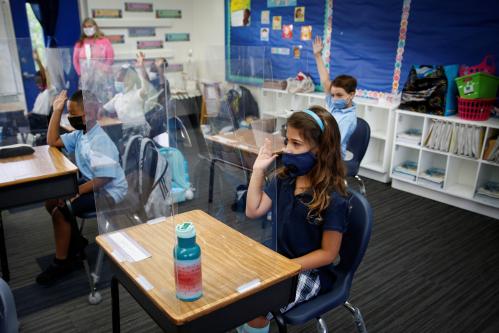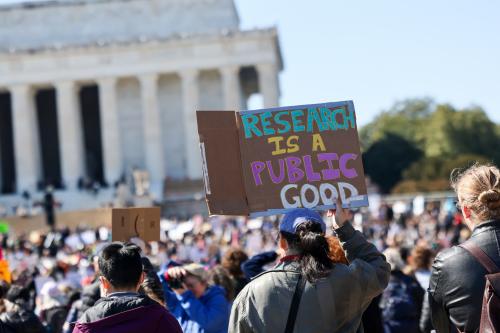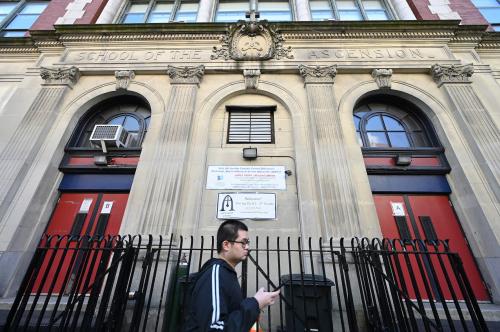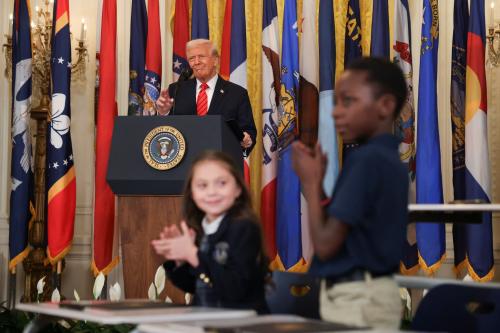Much of the attention on schools during the COVID-19 era has been on learning loss, measured by the drop in student test scores. Overwhelming evidence shows that this is happening—with each new study, we see further documentation that students learned considerably less than they would have without COVID-19. This is important, to be sure, but there are other key signals of skill, knowledge, and development. In particular, high school graduation and college entry are at least as strong as predictors of long-term life success as test scores. How has the pandemic impacted these outcomes?
To address this gap, we—along with Ann Bernhardt, Rylie Martin, Chris Marsicano, and Paul von Hippel—decided to study COVID-19’s effects on high school graduation and the transition from high school to college. We address four main questions:
- First, how has the COVID-19 pandemic affected high school graduation rates? Using data from 25 states, covering 57% of the nation’s school population, our results suggest that high school graduation rates actually increased slightly in the spring of 2020, followed by a return to the prior level in 2021. This pattern is not the result of reporting bias. Overall, it appears that, of all commonly measured educational outcomes, high school graduation has so far been the least affected. We find evidence that multiple factors were at work, especially the temporary relaxation of standards was likely one contributing factor.
- Second, how has COVID-19 affected the transition from high school to college? We find a 16% decline in immediate transitions to two-year colleges and a 6% decline in transition to four-year colleges. Based on the above results, we know this is not because there were fewer high school graduates who could enter. This decline could signal a reduction in future college credentials.
- Third, did these trends vary across student subgroups? High school graduation rates actually increased for students with disabilities, English-language learners, and Black students. However, college entry declined most in colleges serving large proportions of people of color.
- Fourth, why did college enrollment decline even as high school graduation (temporarily) increased slightly? While this question is more difficult to answer, we present a theory that could explain not only the high school graduation and college entry results, but also other patterns in K-12 enrollment. This theory centers on the key differences between starting, persisting, and completing educational credentials.
This blog post outlines our findings. The technical report associated with this work, which provides much more detail, is in the process of release in the Russell Sage Foundation Journal in 2023.
Question 1: How has COVID-19 affected high school graduation rates?
We used data from 25 states that reported high school graduation rates (weighted by enrollment). Figure 1 shows that the graduation rate increased a bit more than the prior trend would have suggested in the spring of 2020, before returning to a level just above the 2019 graduation rate. In short, the total number of high school degrees, summing across the two COVID-19 graduating classes, looks to be very similar to what it likely would have been without the pandemic.
The slight increase and general stability of the graduation rate is likely because states reduced their standards. Essentially every state reduced standards in the immediate aftermath of the pandemic. These fell into three broad categories: relaxing credit requirements, relaxing testing and graduation exam requirements, and relaxing attendance requirements. Even aside from changes in state policies, there were clear declines in teacher expectations for student work.
In this respect, it should be clear that the stability of graduation rates, relative to almost every other metric, is not exactly a victory. These COVID-19-era credentials signal a lower level of aggregate skill than pre-pandemic credentials. On the other hand, by staying somewhat engaged in school, students likely developed more skills than they would have if they had dropped out.
In additional analysis in the technical report, we find various factors across school districts that explain these results: differing instructional modes in districts, changes in state standards, changes in labor-market opportunities for students, and COVID-19 risk. Our findings indicate that reduced state standards and instructional mode played a role in high school completion, but COVID-19 risk and labor-force participation did not.
Question 2: How did COVID-19 affect college entry?
Figure 2 shows college enrollment trends from IPEDS data. In this case, we only have one year of data after COVID-19 started. As above, the “2020 data” are for the 2019-2020 school year, but since we’re now studying initial enrollment, this means the data were collected in fall of 2019—before COVID-19. So, 2021 is the only post-COVID-19 year for college entry.
Unlike high school graduation, the community-college enrollments are clearly lower in 2021 than any of the prior years—16% lower.
We also tried to explain the variation across colleges. The instructional mode of colleges was a key factor, but we again saw no evidence that local COVID-19 transmission affected on-time college entry and mixed evidence about the role of labor-market opportunities.
Question 3: How did the changes in high school graduation and college entry to college vary across student subgroups?
Figure 3 shows high school graduation trends for various student subgroups. This shows that the 2020 increase was larger for English-language learners, students with disabilities, and Black students. Many different factors could have contributed to this pattern. For example, author Harris spoke with an administrator in special education who said that state exams were particularly difficult for students with disabilities pre-COVID-19, so relaxing this standard made it easier to graduate. This is just one example of many possible state- or local-level policy changes that could have disproportionately affected graduation rates for students in these groups.
While we do not have college-entry data by student subgroup, we can report trends by institutional demographics. Figure 4 reports results for community colleges. It separately shows trends for colleges with enrollment that is least 50% Black, 50% Hispanic, and 50% white (as well as other community colleges). This makes clear that the sharpest declines have been for Hispanic-serving institutions, followed by Black-serving and other institutions.
To keep this concise, we have left out the four-year college version of this figure, though the basic patterns are similar.
Question 4: Why are the results so different for high school graduation and initial college entry?
In some respects, we might have expected the results to be more similar in Figures 1 and 2 than what they showed. They both focus on teenagers (aged 17-19). Also, with more high school graduates after the onset of the pandemic, there were more potential college entrants.
While the reasons behind these diverging patterns require more attention, we argue that they might be partially explained by inherent differences between entering an educational institution for the first time versus continuing or graduating. Especially under times of upheaval and stress, people depend on their existing social relationships. Teenagers are especially dependent on their friends. In this case, high school students had been in school with their classmates for many years. They wanted to stay. In contrast, the idea of starting down a new educational path—college—was likely less attractive.
This same basic theory might also help explain some other patterns related to COVID-19. First, it can explain that college entry dipped more than college enrollment in both two-year colleges and (especially) four-year colleges. (The difference between the two sectors is likely because a larger share of total enrollment comes from initial entrants in the two-year sector versus four-year colleges.)
The theory can also explain similar enrollment declines at the K-12 level. Figure 5 below shows the trends in enrollment across grades K-16 from The New York Times. (We note two other studies on K-12 enrollment.) This shows that the largest drop in enrollment, by far, was for kindergarten. Like starting college, children can start kindergarten at different times. The idea of starting school for the first time, with the attendant stresses that arise even without a pandemic, may have seemed like too much. Also, there were no social ties or habits to be broken at that point—just as we saw with college entry.
There is still much we need to learn about educational decisions under COVID-19, and we will have to wait and see whether the drops in initial college enrollment in 2021 are offset by adjustments later. Perhaps high school graduates just redshirted college in the way that kindergartners have often done even before the pandemic, and they will return next year.
Schools and colleges also have roles to play in rebounding from the COVID-19 crisis. We should not think of students returning to schools and colleges that are fixed in stone. While it would have been unreasonable to expect them to be prepared in advance for a once-in-a-century pandemic, faculty and staff have learned a great deal about how to use (and not use) online tools as one part of the educational environment. This creates new opportunities that, if done right, could give students new reason to enter, persist, and complete higher education credentials—and to counteract the difficulties we have seen so far.
The Brookings Institution is committed to quality, independence, and impact.
We are supported by a diverse array of funders. In line with our values and policies, each Brookings publication represents the sole views of its author(s).







